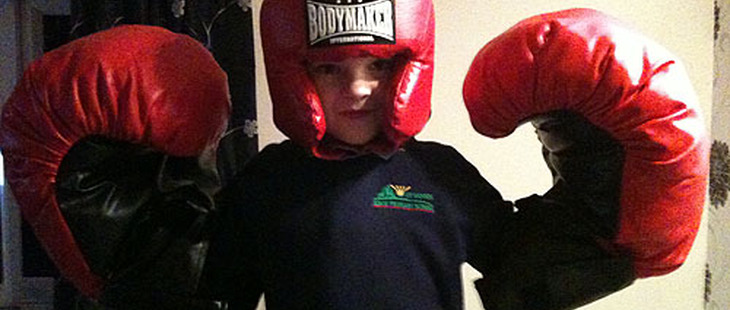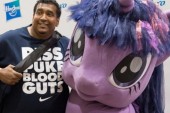

The strange case of Dr Klitschko
Wladimir Klitschko is the most interesting man in the world. At least he might be, especially when you take into account a paragraph like this, written in a profile of him by Kevin Iole: “He’s the kind of guy who can charm housewives as well as their sports-fanatic husbands. Klitschko, who has a doctorate in sports science, speaks five languages and is as adept at discussing international relations as he is at breaking down the heavyweight division.” (Yeah. A doctorate in sports science.)
However, as Klitschko’s dominance in professional boxing’s heavyweight division grows ever more undeniable, he is simultaneously denied the stature, or the recognition, that normally comes along with that kind of feat. As everybody knows, Klitschko successfully defended all of his various championship titles this past weekend against, by anyone’s standards, the very reasonable and talented boxer David Haye. Everybody in Germany, anyway. It seems a fair assessment to say that, especially in the model of mainstream sports broadcasting and reporting, the fate of a sport is closely tied to the fate of its star player(s). But in terms of recognizing a kind of ‘star system’ in how we relate to the best athletes in the sports we most like to follow, the reality of it is that we get most of that coverage (the broadcasting, the reporting, the media attention) from the U.S.
This presents a particular and practical problem. America in general doesn’t have a great track record when it comes to paying attention to things that aren’t, well, American. So it seems to be self-perpetuating relationship: Klitschko’s lack of real presence in the U.S., and the decline of boxing’s popularity. Tennis has this problem to a degree too. Venus and Serena Williams are the only two really big names in American tennis right now, so how much hype was given to Serena’s comeback at Wimbledon, as opposed to the actual championship tennis that was played? Golf has this problem (even though I enthusiastically reported on what Rory McIlroy did for Canada Day — attend Wimbledon). Tiger Woods is the obvious candidate to be the face of golf. His accomplishments in the sport are legendary already. He’s that great American star, destined for the limelight. He even makes golf sexy (but then oops, a little too sexy). And it’s a combination of on-the-course and off-the-course problems that drops Tiger to number 17 in the world golf rankings. So golf, through it’s dimmed spotlight, takes a major hit.
For more than a decade Tiger has been talking publicly about “making golf look more like America.” Oddly, I think the comments were made in primarily an altruistic and positive context. He wasn’t talking about making golf look like America to everyone else in the world, he was talking (in specific reference to his golf foundation that focuses on reaching out to and working with children all over America, regardless of race or privilege) about making golf in America actually reflect and represent the make-up of America. So that it wouldn’t just be a club for white guys. But because of his dominance in the sport and the great story Tiger becomes (until recently), he did, quite literally, make golf look like America. With Tiger out of prominence, golf is feeling the sting of no longer looking like America.
Let him eat
Right when it looks like maybe we’re going to be mired in an American standoff anytime we want a sport in which America doesn’t necessarily dominate the field, or at least the headlines, along comes the fun on (and off) Coney Island. Of all days, oddly it’s the fourth of July that presents an example that’s a little less, I don’t know, digestible, in terms of how America reacts to its sports (or pseudo sports).
Last year, we might recall, Takeru Kobayashi wasn’t permitted to officially participate in the Nathan’s fourth of July hot dog eating contest on Coney Island. Celebrating independence on the fourth of July is as American as apple pie or gorging yourself on hot dogs. I don’t know if the good people at Nathan’s are at all concerned with exporting the Coney Island hot dog eating contest to the rest of the world, but it has been picked up by ESPN (which means that’s it’s a bigger television draw than most of Klitschko’s fights). But the personality that has come along to breathe life into the spectacle is that of Kobayashi, Japanese not American. But he wouldn’t sign an exclusive year-long contract with MLE (Major League Eating), so he isn’t allowed in the competition. He showed up last year and got arrested despite the chants of ‘let him eat’ coming from the crowd. And in the true spirit of independence, this year Kobayashi competed on his own terms, not at the competition at all but at a restaurant in Manhattan, beside a satellite feed of the contest in real time. Kobayashi set a new world record yesterday (69 hot dogs in 10 minutes!) but it won’t count as a sanctioned record. American Joey Chestnut is still champion, winning the Nathan’s International Hot Dog Eating Contest with a final tally of 62 dogs eaten. Chestnut also holds the official competition record of 68 hot dogs. But the way that Kobayashi has flipped the script of American sports is that instead of America vs the world (both in terms of competitive greatness, and media domination) he made the contest Kobayashi vs. the whole competition (vs. the fourth of July, vs. America).
I doubt there’s much of a lesson to be taken away from this for sports like boxing and golf that are battling for the American spotlight. After all, the story still ends up being: how does it all relate to America? I can’t help but wonder what it means that I’m reminded of one of my favorite scenes from The Wire. In the first episode of season 4, Snoop buys a nail gun from a bewildered Hardware Barn employee. She then tells her partner Chris that the salesman said what they had was the Cadillac of nail guns. He meant Lexus, she tells Chris, he just didn’t know it. Now, Cadillac is a longstanding symbol of the American standard of luxury. But a Lexus is from Japan.














